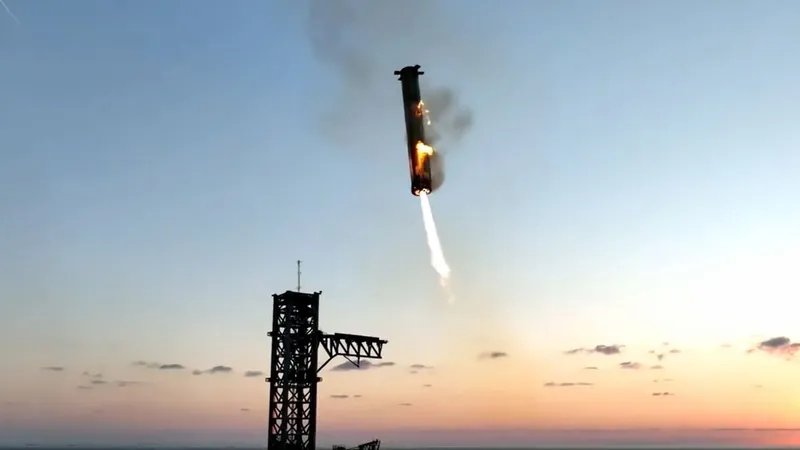
Top 10 Spaceflight Milestones of 2024: A Year of Groundbreaking Achievements
2024-12-28
Author: Sarah
The year 2024 will be etched in history as a pivotal chapter in the saga of space exploration. From remarkable achievements in rocket reusability to ambitious missions aimed at unveiling the mysteries of our celestial neighbors, this year showcased humanity's relentless pursuit of the stars. Here are the top 10 spaceflight stories that defined 2024.
1) SpaceX's Starship Soars to New Heights
In an extraordinary demonstration of innovation, SpaceX achieved a milestone by catching the returning Super Heavy booster from its towering Starship during its fifth test flight on October 13. This unprecedented maneuver involved the launch tower's 'chopstick' arms and marked a significant leap forward in making space travel more sustainable. Following earlier test flights that ended in disaster, the successful lift-off not only made history by achieving orbital speed but also hinted at the future of reusable rockets. Although a later flight on November 19 didn’t replicate the catch, SpaceX plans to execute 25 Starship launches in 2025.
2) Historic Moon Landings
2024 was marked by two landmark moon landings that redefined exploration boundaries. The United States made a groundbreaking return to the lunar surface on February 22 with Intuitive Machines' Odysseus lander, marking the first successful soft landing since Apollo 17 in 1972. Meanwhile, Japan’s JAXA became the fifth country to achieve a lunar landing on January 19 with the Smart Lander for Investigating Moon (SLIM). Though SLIM faced technical difficulties post-landing and was ultimately declared dead, both missions represent significant strides in international lunar exploration.
3) Boeing Starliner’s First Crewed Launch: A Bumpy Ride
On June 5, the Boeing Starliner capsule successfully launched with astronauts for the first time, marking a historic moment for the Atlas rocket family after more than six decades. However, mission complications arose as thruster and helium leak issues jeopardized the return of astronauts Barry Wilmore and Sunita Williams, leading to their extended stay aboard the International Space Station. They are expected to return to Earth no earlier than March 2025 aboard a SpaceX Dragon capsule.
4) China’s Chang'e 6 Returns with Lunar Samples
China's Chang'e 6 mission made a monumental return on June 25, delivering the first samples from the moon's far side. By utilizing advanced technology and a successful assembly and transfer of lunar samples back to Earth, this mission added an enlightening chapter to our understanding of the moon's geology and potentially its history. Initial analysis indicated the samples' unique properties, hinting at new discoveries about our lunar companion's evolution.
5) SpaceX's Polaris Dawn Mission Breaks New Ground
The Polaris Dawn mission, operated by SpaceX and backed by billionaire Jared Isaacman, achieved a historic first: the private spacewalk. The mission, which launched on September 10, not only set the record for the highest altitude reached by a crewed spacecraft but also involved scientific experiments, including testing satellite communication in space. The mission concluded successfully with a splashdown in the Gulf of Mexico, solidifying its status in space exploration history.
6) Europa Clipper Launches on a Quest for Life
NASA's eagerly anticipated Europa Clipper mission aimed at the icy moon Europa, launched on October 14, promises to seek signs of life beneath the moon's frozen exterior. This $5 billion mission involves a sophisticated solar-powered orbiter set to traverse 1.8 billion miles and reach its destination by 2030. The mission holds the potential for groundbreaking discoveries in astrobiology and planetary science.
7) Mars Helicopter Ingenuity's Legacy
After an astounding 72 flights, NASA's Ingenuity helicopter, which proved that powered flight is possible in Mars' atmosphere, was declared operationally concluded on April 16. Ingenuity, initially designed for five flights, exceeded expectations and provided invaluable scouting data for the Perseverance rover. Despite no longer taking to the skies, Ingenuity may serve as a weather station, contributing to future missions.
8) Introduction of ULA’s New Vulcan Centaur Rocket
The United Launch Alliance's Vulcan Centaur rocket made its first two certification launches in 2024, intended to replace the older Atlas and Delta rockets. Although the inaugural mission faced a loss of its payload due to technical malfunctions, the rocket successfully showcased the potential for future national security missions scheduled for early 2025. The European Space Agency also made strides with its Ariane 6 rocket, marking a new era for European launches.
9) NASA Cancels the VIPER Moon Rover Mission
In a surprising move, NASA announced the cancellation of its VIPER moon rover mission on July 17, citing budgetary constraints despite prior achievements in the project's development. Intended to investigate lunar resources, particularly water, VIPER’s tools and technology may still find life in alternative missions, indicating that NASA may leverage its investments in new ways.
10) Oleg Kononenko Breaks Space Record
In 2024, Russian cosmonaut Oleg Kononenko made headlines by setting a new record for the most cumulative time spent in space, surpassing the previous record-holder and adding to Russia's illustrious spaceflight history. This milestone serves as a reminder of the longevity and dedication inherent in human exploration beyond our planet.
2024 not only highlighted significant achievements in space exploration but also set the stage for future advancements and discoveries that could reshape our understanding of the universe.
 Brasil (PT)
Brasil (PT)
 Canada (EN)
Canada (EN)
 Chile (ES)
Chile (ES)
 Česko (CS)
Česko (CS)
 대한민국 (KO)
대한민국 (KO)
 España (ES)
España (ES)
 France (FR)
France (FR)
 Hong Kong (EN)
Hong Kong (EN)
 Italia (IT)
Italia (IT)
 日本 (JA)
日本 (JA)
 Magyarország (HU)
Magyarország (HU)
 Norge (NO)
Norge (NO)
 Polska (PL)
Polska (PL)
 Schweiz (DE)
Schweiz (DE)
 Singapore (EN)
Singapore (EN)
 Sverige (SV)
Sverige (SV)
 Suomi (FI)
Suomi (FI)
 Türkiye (TR)
Türkiye (TR)
 الإمارات العربية المتحدة (AR)
الإمارات العربية المتحدة (AR)